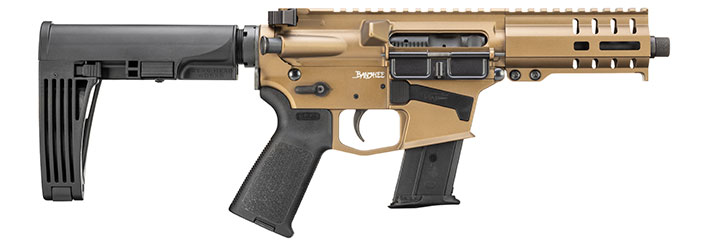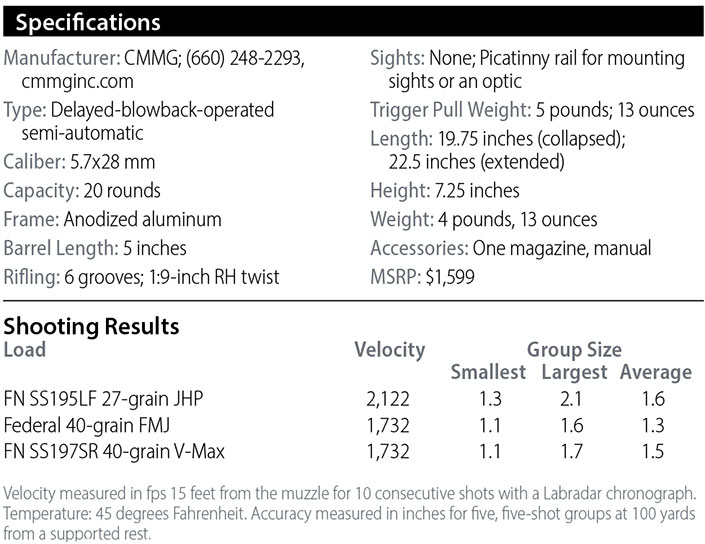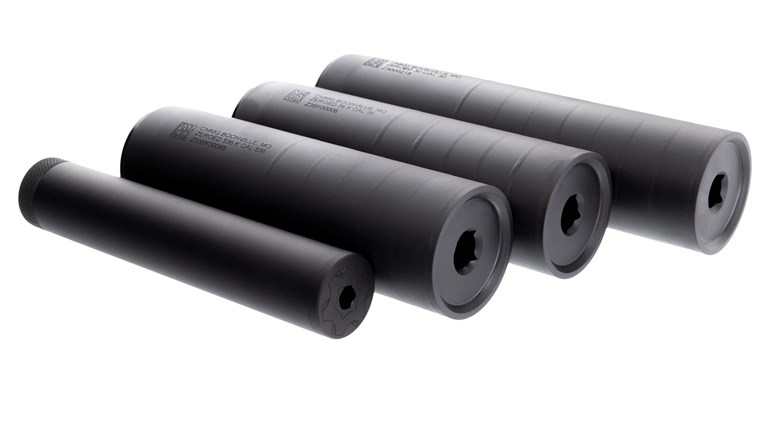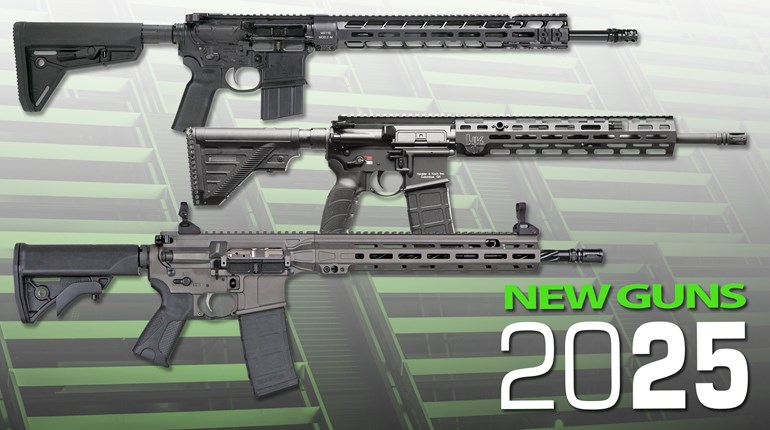
Banshee. \Ban-‘she¯\ Noun, Gaelic, a female spirit of folklore whose appearance or wailing warns that danger is imminent. Wow. I’ve got to say, CMMG knows how to name a firearm.
The company’s Banshee is an AR pistol that stretches boundaries to the point that I’m not really sure just where to start. OK, I threw a dart at the board, and I’ll start with the chambering. CMMG is making the Banshee in 5.7x28 mm. The Five-Point-Seven cartridge came about back in the late ’80s when NATO issued a call for a new item, the Personal Defense Weapon. That firearm was intended to be something light, handy, powerful, easy to use and accurate at a reasonable distance. Something truck drivers, radio operators and crew members of crew-served weapons could have handy, just in case. (We’ll overlook the existence of the M1 carbine at this point, and just move on.)

FN produced the P90, chambered in the attendantly developed 5.7x28 mm. It was all of the above, plus it was high-tech, plastic and looked cool. (It still does.) But, it uses a proprietary magazine, a magazine that cannot be easily adapted to other firearm designs.
Along with the P90 (and the semi-automatic-only PS90) FN introduced the FiveseveN pistol. I visited the FN plant in Liege, Belgium, back in the early years of the 21st century, where I shot both the P90 and the FiveseveN, and was impressed by the soft recoil, accuracy and ease of shooting.
However, the P90 magazines were still a design problem. Adapting some other magazine to accept and reliably feed the miniscule 5.7 cartridge was an obstacle to chambering some firearm other than a P90/PS90 or a FiveseveN. The P90 magazine wouldn’t readily fit any other firearm, and the 5.7x28 mm would not fit into standard pistol magazines.
Well, CMMG solved the problem in an interesting way. It took the basic AR-15 platform, adapted it to take not the P90 magazine, but the FiveseveN magazine, and then put an arm brace on a pistol version of this package, and viola, a PDW.

The P90 and FiveseveN both work as delayed-blowback firearms. The barrel and bolt both recoil a short distance before the barrel stops, and the bolt then continues on its path, extracting and ejecting the fired case. On an AR-15, this is problematic, as the barrel cannot move, and the bolt mass of the AR-15 differs greatly from that of either the P90 or the FiveseveN. So, CMMG took advantage of its clever new approach to blowback ARs; the company’s Radial Delayed Blowback (RDB) system.
The RDB bolt for the 5.7 (and other pistol calibers) looks at first glance like a regular AR bolt. However, the rear faces of the locking lugs, instead of being square to the axis of the bore, are angled. When the cartridge is fired, the bolt thrust now has to cam the bolt lugs back, against the angle of the face bearing on the barrel extension locking lugs, and this effort soaks up enough energy that once unlocked, the system can function as a simple blowback design. The angled lugs delay the extraction to the blowback part of the cycle.
This approach does two things for us: One, the system handles higher-pressure cartridges better than a simple blowback would. Two, to an extent, it is self-adjusting to pressure, as the more bolt thrust there is, the higher the frictional forces resist opening.
The upper receiver is a standard forging, complete with forward assist, ejector lump and flattop rail for mounting optics or BUIS. Forward of that, CMMG has installed a freefloat handguard, with M-Lok slots for accessories. This is the company’s RML4 handguard, cut to the length appropriate to the barrel installed. The barrel is chambered in 5.7x28 mm, with a 1:9-inch twist, and the muzzle is threaded ½-28 tpi so you can install whatever muzzle devices or suppressors you wish. One note: Not all compact suppressors meant for use with rimfire cartridges are rated for use with the 5.7x28 mm. Read the manufacturers data on suppressors before installing one.
The upper comes with the CMMG ambi charging handle, which is a bit oversize and easier to manipulate. If you find the CMMG ambi is a bit too large for your use, tastes or storage needs, you can readily swap it for any other. That’s the beauty of keeping an AR-15 setup as standard as possible.
The lower is even more trick. Instead of pinning in blocks to make a standard AR lower magazine well accept the FiveseveN magazines, CMMG broaches the Banshee lower (from a billet of 7075-T6 aluminum) to accept the FiveseveN magazines properly. The lower has the magazine well angled so the FN magazines are locked in place at the correct angle for feeding. The magazine catch is a big bar across the mag well. The release button is where you expect it to be, but the latch that holds the magazine is on the front of the lower, where the magazine expects it to be. You use standard, unmodified FiveseveN magazines in your Banshee, from FN or ProMag.
Everything else on the Banshee is standard, regular, what-you’d-expect AR-15 layout. The trigger mechanism is a standard single-stage G.I.-type parts kit, but as with much of the rest of the Banshee, if you want something else, you can easily swap in something different. The trigger guard is integral to the lower, not hinged like a G.I.-type lower. But, there’s plenty of room for gloved fingers, should you have the need.

The basic CMMG 5.7 pistol can be had in two models, the Mk 57 Banshee 300 (the one I tested) and the Mk57 Banshee 200 pistol. The Banshee 300 comes with a 5-inch barrel, and on the lower receiver of the Banshee sent to me, CMMG had installed a Gear Head Works Tailhook Mod2 arm brace. You can opt for the CMMG RipBrace, which extends to the desired length just by pulling on it. The Mk57 200 pistol has an 8-inch barrel and the RipBrace.
The Banshee 300 tips the scales, empty, without sights (it comes sans sights, because we all have our own idea about what is proper) at 1 ounce over 4.75 pounds.
When you order your Banshee, you can opt for one of 10 different Cerakote colors, all as single colors; no patterns.
The magazine shipped with it was a ProMag 20-round magazine. The ProMag magazine is a direct replacement for FN magazines (and will work in your FiveseveN if you have one) and worked just fine in the Banshee. You can also use the ProMag 10- and 30-round magazines, as well as FN magazines.
The Gear Head Works arm brace is a rigid polymer brace, with a clamshell-like operation that hinges open. You hinge the rear part open, and then clamp it around your arm, and you’re now braced for one-handed shooting. There is also a small tab recessed on the right side, one that unlocks the brace assembly, so you can adjust its length to accommodate arm length. As a tall shooter with long arms, I appreciate adjustments such as this. They make shooting a lot easier.
When the Banshee arrived, I first thought the box had been delivered empty. A big pistol that weighs a bit over 4 pounds does not make for a hefty big-box shipping package. But there it was, in its Burnt Bronze livery. In checking velocities, I drilled a nice, deep hole in the backstop, indicating it was delivering each shot exactly where I wanted it to.
The CMMG’s accuracy surprised me, though maybe it shouldn’t have. When an AR pistol seriously toys with MOA, you’d be jaded if you weren’t pleased.
The question that many will have is this: Does the 5.7 have the horsepower needed for serious defensive work? In the view of some, the 5.7x28 mm is just a .22 Mag. on steroids. I have to admit to expressing that opinion myself from time to time. And, a 5-inch barrel is not one to inspire confidence in velocities. However, the Banshee delivered some interesting speeds. The 40-grain V-Max bullet is going at a minimum 400 fps faster than a .22 Mag. would from a 5-inch barrel. It would have clocked even higher, but one round was noticeably lower in speed than the others, but was nonetheless factored in.
If an expanding varmint bullet isn’t to your liking for defensive use, then the Federal 40-grain FMJ at the same velocity will likely work better.
What the 5.7 lacks is a bonded, FBI test-compliant bullet, and I suspect that simple physics is at work here. Making a bonded 40-grain bullet is one thing. Getting it to go through the various barriers of the FBI test, in the 1,800- to 2,000-fps velocity range available, is something else.
No, in order to get the light weight, low recoil and low noise levels of the Banshee (wailing aside) you have to pay for it. And the cost is the modest but useful muscle of the 5.7x28 mm cartridge. Given how compact the setup is, and that it could easily be stored just about anywhere, the cost is worth it. With 30 rounds in a magazine, and magazines not taking up much space, you could have the Banshee handy, with plenty of ammo, in not much space or adding much weight.
Add in that the ergonomics of the Banshee are identical to the AR-15 you’ve been practicing with all these years, and the Banshee is looking even better.








































